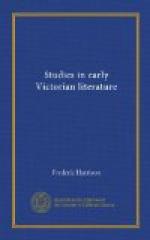Here we have Macaulay in all his strength and all his limitations. The passage contains in the main a solid truth—a truth which was very little accepted in England in the year 1840—a truth of vast import and very needful to assert. And this truth is clothed in such pomp of illustration, and is hammered into the mind with such accumulated blows; it is so clear, so hard, so coruscating with images, that it is impossible to escape its effect. The paragraph is one never to be forgotten, and not easy to be refuted or qualified. No intelligent tiro in history can read that page without being set a-thinking, without feeling that he has a formidable problem to solve. Tens of thousands of young minds must have had that deeply-coloured picture of Rome visibly before them in many a Protestant home in England and in America. Now, all this is a very great merit. To have posed a great historical problem, at a time when it was very faintly grasped, and to have sent it ringing across the English-speaking world in such a form that he who runs may read—nay, he who rides, he who sails, he who watches sheep or stock must read—this is a real and signal service conferred on literature and on thought. Compare this solid sense with Carlyle’s ribaldry about “the three-hatted Papa,” “pig’s wash,” “servants of the Devil,” “this accursed nightmare,” and the rest of his execrations—and we see the difference between the sane judgment of the man of the world and the prejudices of intolerant fanaticism.




